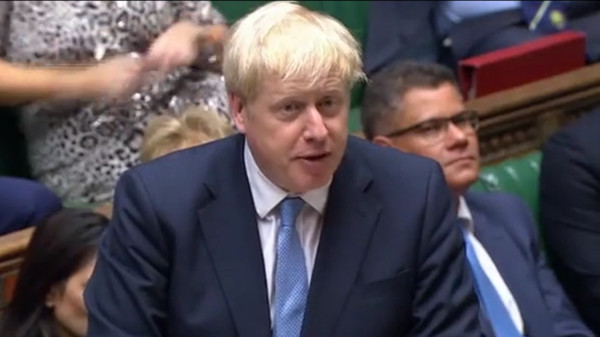Boris Johnson expressed his "passionate" support for nuclear power when he addressed the House of Commons for the first time as UK prime minister yesterday. Seven of the country’s eight existing nuclear plants are set to be retired by 2030, while new-build projects have faced financial uncertainty over the last two years.

Prime Minister Boris Johnson in the House of Commons yesterday. (Image: Parliament.tv)
Johnson was asked a question by Trudy Harrison, the member of parliament for Copeland, which is the borough in western Cumbria that includes Sellafield, the nuclear fuel reprocessing and nuclear decommissioning site, and also the proposed site of the abandoned Moorside nuclear power plant project.
She asked him whether he agreed that "the time is now for a nuclear renaissance", adding that Copeland is a "centre of nuclear excellence".
Johnson replied: "It is time for a nuclear renaissance and I believe passionately that nuclear must be part of our energy mix," adding that nuclear energy will help the country meet its carbon emission reduction targets.
On 22 July, the day that Johnson was elected leader of the Conservative Party and two days before he officially replaced Theresa May as prime minister, the government launched a consultation into funding large-scale nuclear power plants and a proposed GBP18 million (USD22 million) investment into small modular reactors.
Greg Clark, secretary of state for the Department for Business, Energy and Industrial Strategy (BEIS) - who Johnson replaced this week with Andrea Leadsom - announced in June 2018 that the government would review the viability of a Regulated Asset Base (RAB) model for new nuclear projects. The consultation states that, as the cost of renewable technologies continues to fall, they are likely to provide the majority of the country's low-carbon generating capacity in 2050. It adds however there will still be a crucial role for low-carbon 'firm' - always available - power in 2050.
The RAB model would not apply to Hinkley Point C (HPC), which is currently under construction by EDF Energy in Somerset, England, but would apply to future plants. As many as five more new-build projects had been planned - by EDF Energy together with China General Nuclear (CGN); NuGeneration (NuGen); and Horizon Nuclear Power.
French-owned EDF Energy is building two European Pressurised Reactors (EPRs) at Hinkley Point with CGN owning a 33.5% stake in the project. They also plan to build new plants at Sizewell in Suffolk and Bradwell in Essex, the latter using Chinese reactor technology. UK-based engineering company Atkins, a member of SNC-Lavalin Group, announced yesterday that it had been awarded a GBP5.0 million contract for the enabling works basic design at the Sizewell C site. It will be the first programme of construction work to start at the proposed twin-EPR nuclear power plant.
In November last year, Toshiba Corp announced it was scrapping its nuclear new-build project at Moorside and would wind up its subsidiary managing the project, NuGen. The aim had been to build a nuclear power plant of up to 3.8 GWe gross capacity using AP1000 nuclear reactor technology provided by Westinghouse. The reactor design completed the Generic Design Assessment (GDA) process in March 2017, the same month that Toshiba-owned Westinghouse filed for Chapter 11 protection with US courts.
Then, early this year, Horizon's new-build projects were suspended even though the UK subsidiary of Japan’s Hitachi had made substantial progress with its plans to provide at least 5.4 GWe of new capacity across two sites - Wylfa Newydd, in north Wales, and Oldbury-on-Severn, in southwest England - by deploying Hitachi-GE UK advanced boiling water reactors. The UK ABWR design successfully completed the GDA process in December 2017. Horizon welcomed the government’s launch of the RAB consultation, saying that a new funding and financing model was “one of the essential steps” if it is to restart its development activities.